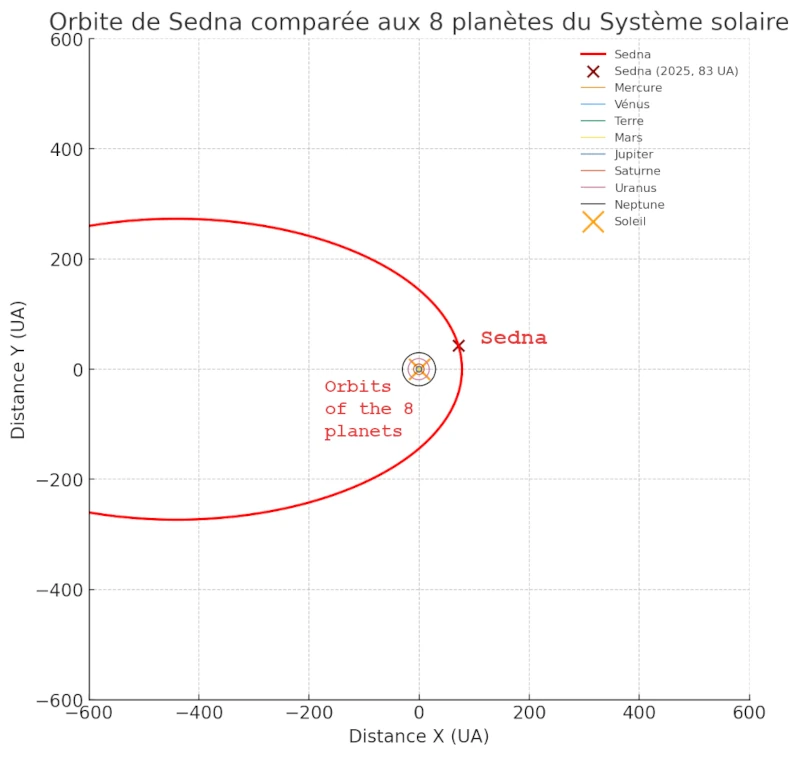
Discovered in 2003 by Mike Brown (1965-), Chad Trujillo (1973-), and David Rabinowitz (1958-), Sedna is a reddish dwarf planet located at a distance ranging from 76 to 937 astronomical units (AU) from the Sun. Its orbit is one of the most eccentric known: \( e = 0.85 \). Its orbital period is approximately \( 11,400 \) years. Sedna is near perihelion, slowly approaching the Sun (orbital speed ≈ 1.04 km/s). This means detailed observation will be possible in the second half of the 21st century, when its distance decreases by about 7 AU to its closest point. As of 2025, it is approximately 83.2 AU (about 12.4 billion kilometers) from the Sun, or about 2.5 times Neptune's distance from the Sun.
Sedna moves in an intermediate zone of the Solar System, located between the Kuiper Belt and the Oort Cloud. This unique position makes it a key object for understanding the transition between the planetary region and the outer cometary reservoir. It may be a remnant of the early Solar System's formation.
N.B.:
The name Sedna comes from Inuit mythology, where she is the goddess of the sea and marine creatures, ruling over the icy depths of the Arctic Ocean. According to legend, Sedna—a young woman transformed into a sea spirit after a family tragedy—embodies both the power and fragility of polar ecosystems. Her astronomical counterpart, the dwarf planet 90377 Sedna, shares this symbolism of extreme isolation: just as the goddess dwells in the abyss, the celestial object orbits at the farthest reaches of the Solar System, between the Kuiper Belt and the Oort Cloud, in near-perpetual freezing darkness. This onomastic choice, proposed by its discoverers in 2004, thus underscores its enigmatic and frontier nature.
Several hypotheses have been proposed to explain Sedna's abnormal orbit. One, supported by Alessandro Morbidelli (1966-), suggests Sedna was disturbed by a star passing near the Sun during the original cluster phase. Another theory, advocated by Konstantin Batygin (1986-), involves the gravitational influence of a potential ninth planet, "Planet Nine."
This zone thus represents a hybrid dynamic space between solar influence and the local interstellar medium.
Spectroscopic observations show that Sedna's surface contains frozen methane (CH\(_4\)), nitrogen ice (N\(_2\)), and tholins, products of organic compound photolysis. Its average temperature is estimated at about \( -240\,^{\circ}\mathrm{C} \). This cold, complex chemistry suggests formation far from the Sun, where ultraviolet radiation plays a dominant role.
Due to its slow orbit and distance, Sedna has not yet reached its aphelion, expected in about 6,000 years.
| Object | Semi-major axis (AU) | Eccentricity | Orbital period (years) | Comment |
|---|---|---|---|---|
| Sedna | 518.6 | 0.85 | ≈ 11,400 | Highly eccentric orbit; may mark the transition between the Kuiper Belt and the Oort Cloud. |
Sources: NASA JPL Small-Body Database, The Astrophysical Journal Letters, Astronoo.